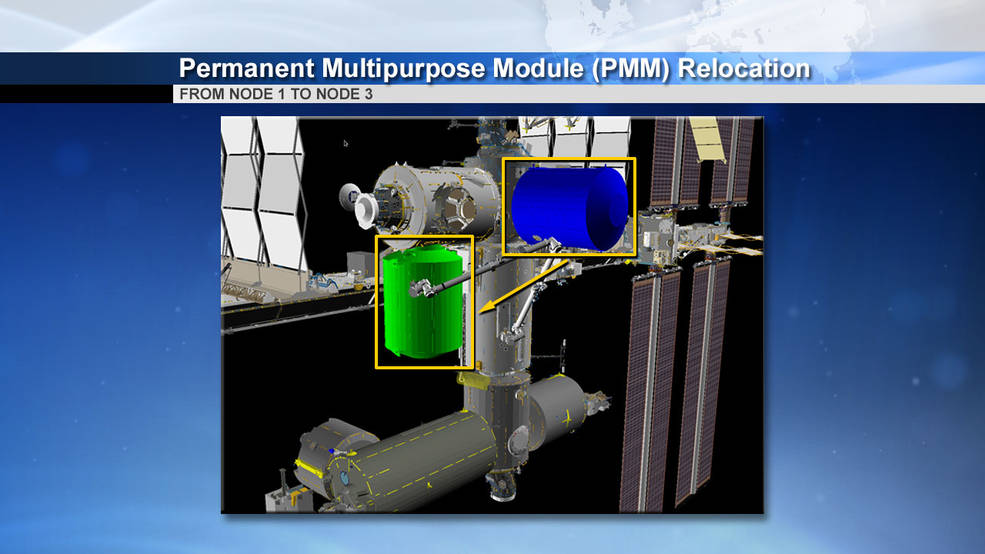
Continuing an ambitious year which will see the most significant reconfiguration of International Space Station (ISS) hardware since the twilight of the Space Shuttle era, NASA will robotically detach the Leonardo Permanent Multipurpose Module (PMM) on Wednesday, 27 May, from its present position at the Earth-facing (or “nadir”) interface of the Unity node to a new place at the forward-facing port of the Tranquility node. As described in a previous AmericaSpace article, this is an initial step to reconfigure Unity nadir as a backup location for the berthing of unpiloted cargo craft—including SpaceX’s Dragon and Orbital Sciences’ Cygnus—as NASA works to transform the forward and space-facing (or “zenith”) interfaces of the Harmony node from berthing locations into docking ports for future Commercial Crew vehicles. According to NASA, the multi-hour Leonardo PMM relocation task will be aired on NASA TV, beginning at 8 a.m. EDT Wednesday. At the same time, Roscosmos yesterday (Friday) issued preliminary details for the cause of last month’s Progress M-27M failure, and an overview of the realigned ISS manifest for the remainder of 2015 is steadily taking shape.
Originally targeted to occur no sooner than mid-June, the Leonardo PMM relocation was brought forward by several weeks, due to a reshuffling of ISS priorities in the aftermath of the much-publicized Progress M-27M failure. The latter, launched from the Baikonur Cosmodrome in Kazakhstan on 28 April, was intended to ferry 5,196 pounds (2,357 kg) of food, water, supplies, hardware and experiments to the space station’s incumbent Expedition 43 crew, which consists of Commander Terry Virts, Italy’s first woman in space, Samantha Cristoforetti, Russian cosmonauts Anton Shkaplerov and Gennadi Padalka and One-Year crewmen Scott Kelly and Mikhail Kornienko.
Following launch, Progress M-27M was supposed to follow a now-standard six-hour, four-orbit “fast rendezvous”, ahead of an automated docking at the station’s Pirs module. However, its Soyuz-2 booster experienced a malfunction near the end of its upper-stage “burn”, just prior to spacecraft separation, with strong suspicion that some kind of blast had occurred, imparting a rotational spin and generating a large debris field, totaling as many as 44 discrete objects. Intermittent communications provided flight controllers with limited telemetry, which indicated that Progress M-27M had satisfactorily deployed its electricity-generating solar arrays, but no confirmation that its Kurs (“Course”) rendezvous antennas had unfurled. In keeping with procedures which are common to both unpiloted Progress and crewed Soyuz flights, the fast rendezvous profile was abandoned in favor of a standard two-day approach regime.
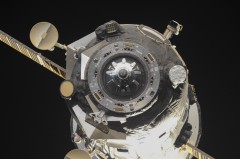
However, this quickly proved untenable, in view of the shaky communications and no success in efforts to overcome Progress M-27M’s uncontrollable spin. By 29 April, Roscosmos reported that the spacecraft was effectively lost, having sustained multiple systems failures and depressurized propellant lines, and that it would likely re-enter Earth’s atmosphere to destruction at some stage between 7-11 May. At length, the spacecraft burned up over a sparse and uninhabited region of the Pacific Ocean, between 560 miles (350 km) and 2,000 miles (1,300 km) off the west coast of Chile, early on 8 May. It was a sad end to the 150th Progress mission, the latest in a long and illustrious line of unpiloted cargo vehicles which have near-flawlessly resupplied the Soviet Union’s Salyut 6 and Salyut 7 space stations, Russia’s Mir and today’s ISS, for more than 37 years. Only two Progresses—the other being Progress M-12M, which was lost in a launch accident in August 2011—have ever failed to reach their destination.
Since the unpiloted Progress and crewed Soyuz are both launched atop similar variants of the same “family” of boosters, it was considered prudent to postpone the Soyuz TMA-17M mission—crewed by Russian cosmonaut Oleg Kononenko, U.S. astronaut Kjell Lindgren and Japan’s Kimiya Yui—from its original 26 May target until no sooner than the second half of July. Additionally, it was decided that the next use of the Soyuz booster will be Progress M-28M, originally scheduled to fly from Baikonur on 6 August, but advanced to the first week of July. However, it was noted that the ISS is in no danger, from a consumables perspective, and is sufficiently stocked until the fall. “Under our laws, we cannot make a manned launch next, so we suggested, and Roscosmos supported us, that it would be expedient to launch a Progress cargo ship,” explained Vladimir Solovyov, flight director of the Russian Orbital Segment (ROS). “A different carrier rocket with a different third stage will be used. Preliminarily, we plan to launch a Soyuz with another expedition in late July.” Current expectations call for the launch of Progress M-28M on 3 July and Soyuz TMA-17M on 24 July, both from Baikonur.
Following the Progress M-27M failure, it was expected that an update on the investigation would be issued by the State Commission on Friday, 22 May. It had earlier been reported by Igor Komarov, the head of Roscosmos, that the loss was “due to depressurization of the oxidizer tank and fuel tank in…the third stage” of the Soyuz-2 booster. Mr. Komarov explained that the malfunction placed the launch vehicle about 12 miles (20 km) lower than predicted and subsequently left Progress M-27M about 25 miles (40 km) above the calculated orbit. Yesterday, Roscosmos announced that the final conclusions of the commission would be reported on Tuesday, 26 May, but Interfax highlighted that experts had examined dozens of mathematical models of the situation—beginning just a few seconds after the spacecraft separated from the booster—which were assisted by in-depth computational and theoretical studies and experimental work.
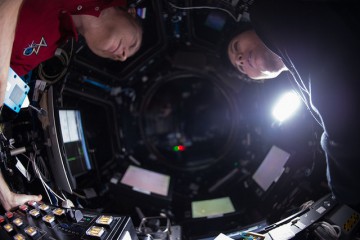
The results of this investigation are expected to allow NASA, Roscosmos and the International Partners to firm up the ISS manifest for the remainder of 2015. Under normal circumstances, the space station follows an “indirect” rotation of its six-member expeditions, whereby a given three-person subset departs, reducing the population to three, after which a fresh three-member team arrives about two weeks later to restore the crew back up to six. However, with Soyuz TMA-15M and Virts, Shkaplerov and Cristoforetti originally scheduled to return to Earth on 14 May, and Soyuz TMA-17M postponed until late July, it was recognized that this would reduce the ISS crew to three members for an unexpectedly protracted period of time. As a consequence, NASA and the International Partners agreed to delay the Soyuz TMA-15M return until 11 June, producing a 199-day mission for the three spacefarers—the second-longest ISS expedition in history—and making Cristoforetti the most flight-experienced Italian astronaut of all time and holder of the record for the longest single space mission ever completed by a woman.
This also opened up a new window of time in what had previously been a busy few weeks of visiting vehicle departures and arrivals, allowing NASA to advance its Leonardo PMM relocation plan. With a full U.S. Orbital Segment (USOS) crew of Virts, Cristoforetti and Kelly, through the first half of June, SpaceX’s CRS-6 Dragon cargo ship was robotically detached from the Harmony nadir interface and returned safely to Earth, last Thursday, and allowed the complex Leonardo PMM maneuver—detailed in a recent NASA animation—to be brought forward to Wednesday, 27 May.
According to NASA’s Rob Navias, the relocation will take “a few hours”, with “the previous and following days involved in internal systems configuration”. It was noted that this internal activity will consist of jumper cable and valve configuration work for Unity and Tranquility to accommodate the relocation. The actual transfer of the Leonardo PMM by the space station’s 57.7-foot-long (17.6-meter) Canadarm2 robotic arm will be conducted by the Robotics Officer (ROBO) in the Mission Control Center (MCC) at the Johnson Space Center (JSC) in Houston, Texas, whilst the Expedition 43 crew will carry responsibility for configuring the Common Berthing Mechanisms (CBMs) at the Unity nadir and Tranquility forward interfaces. Specifically, they will install a “Node-1 Berthing Kit” inside Unity to provide power and data support for future unpiloted visitors.
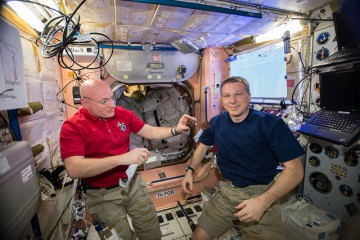
“Expedition 43 Commander Terry Virts and Flight Engineer Scott Kelly of NASA will supervise the unbolting of the module from Unity and its final attachment to Tranquility,” it was reported yesterday (Friday). “Virts and Kelly will close the hatch to the module on Tuesday, 26 May, and reopen it at its new location on Thursday, 28 May.” The Italian-built Leonardo PMM began its operational life as a Multi-Purpose Logistics Module (MPLM) and launched aboard the shuttle on eight occasions between March 2001 and its permanent installation on the ISS in February 2011. Weighing 22,000 pounds (10,000 kg), the module measures 22 feet (6.7 meters) in length and 14 feet (4.2 meters) in diameter and now serves, in effect, as a “supply depot” for spares, supplies and waste.
“We expect the relocation itself to take a few hours,” NASA’s Rob Navias told AmericaSpace, “with the previous and following days involved in internal systems configuration.” It was noted that this internal activity will consist of jumper cable and valve configuration work for Unity and Tranquility to accommodate the relocation. According to Mr. Navias, the actual movement of the Leonardo PMM by the space station’s Canadarm2 robotic arm will be conducted by the Robotics Officer (ROBO) in Mission Control, whilst the Expedition 43 crew will be responsible for configuring the Common Berthing Mechanisms (CBMs) at the Unity nadir and Tranquility forward interfaces. Specifically, the astronauts will install a “Node-1 Berthing Kit” inside Unity to provide power and data support for future unpiloted visitors. Several external work tasks at Tranquility forward—including the removal of a Non-Propulsive Vent (NPV) and an obstructive handrail, the release of Launch Locks, the opening of a Centerline Berthing Camera System (CBCS) “flap” and a visual check of the satisfactory performance of the CBM “petals”—were performed during February’s EVA-30 by Expedition 42 Commander Barry “Butch” Wilmore.
The significance of the Leonardo PMM relocation was not lost on Chief Astronaut Bob Behnken, who tweeted late Friday: “Next week @space_station crew moves module in prep for @BoeingDefense & @SpaceX crew vehicles.”
The ISS manifest for the remainder of the year is steadily taking shape and Novosti Kosmonavtiki has reported that the undocking of Soyuz TMA-15 from the station’s Earth-facing Rassvet module is anticipated around 12 noon Moscow Time (5 a.m. EDT) on 11 June, with touchdown in central Kazakhstan anticipated at 4:40 p.m. Moscow Time (9:40 a.m. EDT). The crew was launched from Baikonur, last 23/24 November. If those times hold, it will bring to an end a mission of 199 days, 16 hours and 39 minutes for Virts, Shkaplerov and Cristoforetti, which represents the second-longest ISS expedition in history—just two weeks shy of the 215 days spent aloft by Expedition 14 crewmen Mike Lopez-Alegria and Mikhail Tyurin between September 2006 and April 2007—and will set a new raft of records for Italy. Specifically, Cristoforetti has already smashed fellow countryman Paolo Nespoli’s 174-day cumulative record to become the most experienced Italian spacefarer in history. Passing 195 days on 7 June, she will also surpass U.S. astronaut Suni Williams to become the holder of the record for the longest single space mission ever undertaken by a woman.
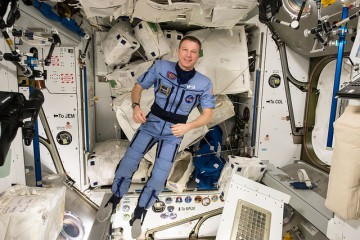
The departure of Virts, Shkaplerov and Cristoforetti will leave the station under the command of Gennadi Padalka—the first human to lead as many as four discrete ISS expeditions—who will make history on 28 June, when he eclipses fellow cosmonaut Sergei Krikalev to become the world’s most experienced spacefarer, surpassing a cumulative time of 803 days across his five missions. By the time Padalka returns to Earth in mid-September, he will have amassed a total of 878 days in orbit, which represents about 2.4 years of his 57 years of life spent off the Home Planet. Joining Padalka for Expedition 44 will be Kornienko and Kelly, who are expected to remain aboard the ISS through March 2016. The second half of the Expedition 44 crew is expected to arrive on 24 July, when Soyuz TMA-17M launches and delivers Kononenko, Lindgren and Yui to the station.
In the meantime, it is anticipated that two unpiloted visitors will be despatched to the ISS in the coming weeks. The launch of SpaceX’s CRS-7 Dragon cargo ship has been realigned from its original target of 19 June to occur No Earlier Than (NET) 26 June, with an “instantaneous” window opening at 11:09 a.m. EDT. Aboard the Dragon’s unpressurized “trunk” will be the first of two International Docking Adapters (IDA-1), which will be removed and installed onto Pressurized Mating Adapter (PMA)-2 at the forward end of the Harmony node during a joint spacewalking and robotics operation on U.S. EVA-32, to be performed by Kelly and Lindgren, later this summer. This will serve as the primary docking interface for Commercial Crew vehicles from 2017 onwards. Interestingly, the arrival of the CRS-7 Dragon will occur about two days after launch, meaning that for the first time there will be only one USOS crew member—Scott Kelly—aboard the space station, although Padalka and Kornienko will be at his side to assist. All previous Dragon visitors have occurred with at least two USOS crew in residence.
With most Dragon missions remaining berthed at the ISS for no longer than about five weeks, AmericaSpace asked SpaceX if the realignment of the CRS-7 launch was due to a specific technical issue or if it was related to the gap between the cargo ship’s arrival at the station and the earliest possible date that IDA-1 could be removed from its trunk and EVA-32 performed after Lindgren’s arrival. “No specific issue and the shift is not related to the IDA, just allows a bit more time for vehicle processing,” SpaceX told us. “The max time for Dragon at station can vary, so it’s tough to give a definitive answer. In the DragonLab configuration, Dragon could conceivably be on-orbit for up to two years, but for station missions, Dragon is typically expected to remain berthed between roughly 3-5 weeks.” This would produce a possible EVA-32 as early as the beginning of August, just a few days after Lindgren’s arrival.
Two weeks after CRS-7 arrives, the launch of Progress M-28M on 3 July is expected to return the Soyuz booster back to operational service, ahead of the Soyuz TMA-17M crew, who will follow no earlier than 24 July. Most other ISS milestones for the remainder of 2015 remain unaffected. Japan’s fifth H-II Transfer Vehicle (HTV-5) is targeted for mid-August and will be robotically berthed, via Canadarm2, at the nadir port of the Harmony node, where it will remain until October. However, with SpaceX’s CRS-8 Dragon expected to fly in early September—carrying the Bigelow Expandable Activity Module (BEAM)—there will exist a unique situation of having two unpiloted visiting vehicles in residence at the USOS for the very first time.
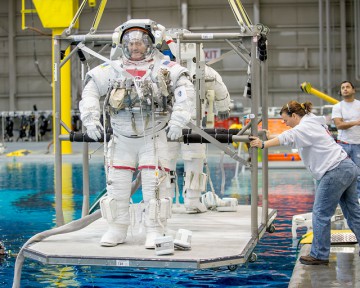
Originally, the plan was to berth HTV-5 at Harmony nadir, then robotically transfer it to Unity nadir a few days later, to make room for the arrival of the CRS-8 Dragon. With CRS-8 due to depart before HTV-5, the Harmony nadir port would thus be vacated in sufficient time for the Japanese cargo ship to be robotically transferred on final time back to Harmony for its final unberthing and departure. “HTV needs to berth and unberth from Harmony, due to proximity ops equipment interference,” NASA’s Rob Navias told AmericaSpace, back in March. More recently, however, it appears that the need for this unusual, two-step process has been eliminated. “Further analysis has indicated that HTV could depart from either Unity or Harmony,” Mr. Navias explained in mid-May. “The possible plan to relocate HTV from its initial berthing port at Harmony nadir to Unity nadir is designed to accommodate two visiting vehicles at the USOS segment at the same time, like we will ultimately see anyway once Commercial Crew operations begin. In this case, the preliminary plan would be to relocate HTV to accommodate Dragon CRS-8 at Harmony nadir, but time will tell whether that will be needed at this time.”
Like an Earth-orbital game of musical chairs, the late summer will be a busy time at the ISS. Russia’s Progress M-26M spacecraft—which has been in residence since mid-February—will depart the aft longitudinal port of the station’s Zvezda module on 26 August, freeing up this docking location for the infrequent presence of as many as three piloted Soyuz craft and a “direct handover” of crew members in the first half of September. The departure of Progress M-26M will allow Padalka, Kornienko and Kelly to perform a short, 25-minute “hop” to transfer their Soyuz TMA-16M craft from the zenith-facing Poisk module to Zvezda aft, thereby making room for the arrival of Soyuz TMA-18M on 1 September.
With Kelly and Kornienko embarking on a mission of almost a full year, and with Padalka scheduled to return to Earth after six months, a replacement Soyuz commander was required to join them for the second half of their long voyage. As such, veteran cosmonaut Sergei Volkov will command Soyuz TMA-18M, joined by Andreas Mogensen, Denmark’s first astronaut, representing the European Space Agency (ESA), and until recently by English soprano Sarah Brightman as a Spaceflight Participant (SFP). Brightman’s recent withdrawal from the mission leaves open the possibility of whether her backup—Japanese advertising entrepreneur Satoshi Takamatsu—will fly in her stead or if Soyuz TMA-18M will fly with just Volkov and Mogensen and payload in the place of the third crew member.
With the arrival of these three, the ISS will play host to three Soyuz and nine crew members for the first time in almost two years. ISS Program managers prefer to utilize the lateral Poisk and Rassvet modules for Soyuz dockings, in order that Zvezda aft—which runs along the station’s longitudinal axis—can be employed by Progress or Automated Transfer Vehicles (ATVs) for orbital reboost maneuvers. Since Soyuz TMA-16M is due to depart the ISS on 11 September and the next Progress is not expected to arrive until late October, a brief presence at Zvezda’s aft port will not pose any visiting vehicle traffic complications. Soyuz TMA-16M will return to Earth with Padalka and Mogensen, with on-orbit leadership of the ISS handed over to Scott Kelly, who will command Expeditions 45 and 46 through early March 2016. During this period, the crews will welcome Progress M-29M in late September, Orbital Sciences’ ORB-4 Cygnus in November. Moreover, in October, Kelly will set two empirical U.S. endurance records. On the 14th, he will surpass Mike Fincke’s 381-day cumulative achievement as the most experienced U.S. spacefarer, and on the 28th, he will eclipse Mike Lopez-Alegria’s accomplishment of 215 days in a single mission.
Pressing ahead with the USOS reconfiguration effort, the robotic transfer of the Pressurized Mating Adapter (PMA)-3 from its current location on the Tranquility node to the zenith face of Harmony—thus providing the basis for a backup Commercial Crew docking interface—is scheduled to occur in October. It will be followed shortly afterwards by a pair of EVAs, likely by Kelly and Lindgren, to prepare PMA-3 for the arrival of the second International Docking Adapter, IDA-2, in December, aboard the CRS-9 Dragon. Following the arrival of IDA-2, a further U.S. EVA will be conducted to maneuver the new docking port into position.
As 2015 enters its final weeks, it seems likely that there will be some shifting to the right of the expedition crews. Original plans called for Kononenko, Lindgren and Yui to return to Earth on 5 November, closing out an increment of 163 days. However, the two-month delay to their launch would have shortened their stay by a substantial margin, to just 104 days. According to Novosti Kosmonavtiki, there exists the possibility that the Soyuz TMA-17M increment may be extended to 22 December, after the launch of Soyuz TMA-19M and its crew of Russian cosmonaut Yuri Malenchenko, U.S. astronaut Tim Kopra and Britain’s Tim Peake, which appears to have moved to 19 December. This would produce a second direct handover of ISS resident crews in 2015.
Want to keep up-to-date with all things space? Be sure to “Like” AmericaSpace on Facebook and follow us on Twitter: @AmericaSpace




http://www.alladinstips.com/hamilton/2275d-60157-hamilton64.htmlハミルトン カーキ クオーツ,ハミルトン カーキ チタン,ニナリッチ 財布 レディース
ハミルトン レディース 腕時計,ハミルトン 腕時計 メンズ クオーツ,ニナリッチ 財布 年齢 http://utahtriathlonclub.org/prostomag/115e9-90153-hamilton25.html
http://sstworkshop.com/prostomag/29c8f-90159-hamilton82.htmlハミルトン 腕時計 メンズ ジャズマスター,ハミルトン レディース 自動巻き,ニナリッチ 香水 アーモンド
ハミルトン ベンチュラ ベルト,ハミルトン 腕時計 メンズ カーキ,ニナリッチ 香水 トマト http://beaconwoodsgolf.com/prostomag/2004c-50156-hamilton57.html
http://weibo.xiucaozuo.com/prostomag/24e6d-70157-hamilton74.htmlハミルトン 腕時計 レディース ヴィンテージ,ハミルトン カーキ クオーツ,ニナリッチ 財布 年齢層
ハミルトン 腕時計 メンズ ベンチュラ,ハミルトン カーキ フィールド,ニナリッチ 財布 ピンク http://www.reluma.com.pl/prostomag/2c39f-00159-hamilton85.html